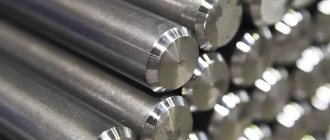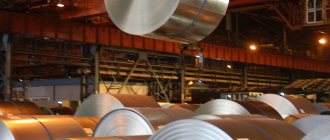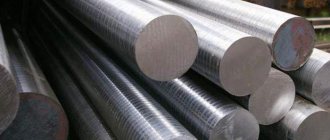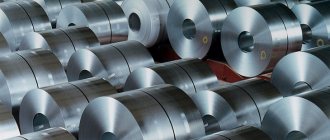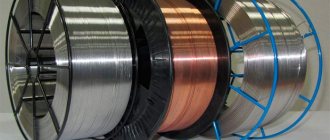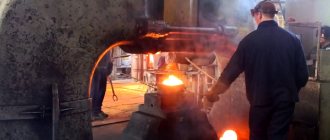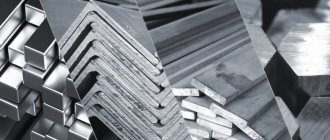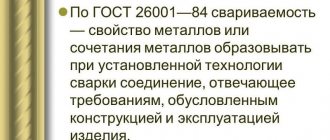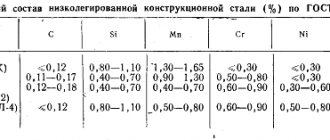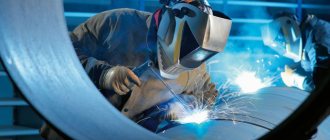Types and grades of steel
Steel is an alloy of iron and carbon with other elements, the carbon content in it is no more than 2.14%.
The most general characteristic is that steel is classified according to its chemical composition:
- carbon steel (Fe – iron, C – carbon, Mn – manganese, Si – silicon, S – sulfur, P – phosphorus). Based on carbon content, it is divided into low-carbon, medium-carbon and high-carbon. Carbon steel is designed for statically loaded tools.
- alloy steel - alloying elements are added: nitrogen, boron, aluminum, carbon, phosphorus, cobalt, silicon, vanadium, copper, molybdenum, manganese, titanium, zirconium, chromium, tungsten, nickel, niobium.
According to the production method and impurity content, steel differs:
- ordinary quality steel (carbon less than 0.6%) – corresponds to GOST 14637, GOST 380-94. St0, St1, St2, St3, St4, St5, St6. The letters “St” indicate ordinary quality steel, the numbers indicate the marking number depending on the mechanical properties. It is the cheapest steel, but inferior in other qualities.
- high-quality steel (carbon or alloy) - GOST 1577, carbon content is indicated in hundredths of % - 08, 10, 25, 40, the degree of deoxidation and the nature of solidification can additionally be indicated. High-quality carbon steel has high ductility and increased weldability.
Low-carbon high-quality structural steels are characterized by low strength and high ductility. Parts for cold stamping are made from sheet steel 08, 10, 08kp. Bolts, screws, nuts, axles, hooks, studs and other parts for non-essential purposes are made from steels 15 and 20.
Medium-carbon quality steels (st. 30, 35, 40, 45, 50, 55) are used after normalization and surface hardening for the manufacture of parts that have high strength and core toughness (axles, screws, bushings, etc.)
Steel 60 - steel 85 have high strength, wear resistance, and elastic properties. Crane wheels, rolling rolls, compressor valves, springs, leaf springs, etc. are made from them.
- high quality - complex chemical composition with low phosphorus and sulfur content - according to GOST 19281.
Steel is also divided by application:
- construction steel - carbon steel of ordinary quality. Has excellent weldability. The number indicates the conditional number of the steel composition according to GOST. The higher the reference number, the higher the carbon content, the higher the strength of the steel and the lower the ductility.
- structural steel - GOST 1050
Carbon-based high-quality structural steels are used in mechanical engineering, for welded, bolted structures, for roofing work, for the manufacture of rails, railway wheels, shafts, gears and other parts of forklifts. The numbers in the marking indicate the carbon content in tenths of a percent.
Structural alloy steels are used for tractor tracks, the manufacture of springs, leaf springs, axles, shafts, automobile parts, turbine parts, etc.
- tool steel - used for cutting tools, high-speed steel for cold and hot deformation of materials, for measuring instruments, for the production of hammers, chisels, chisels, cutters, drills, files, razors, rasps.
- alloy steel is a universal steel containing a special impurity. Silicon content more than 0.5%, manganese more than 1%. GOST 19281-89. If the content of the alloying element exceeds 1 - 1.5%, then it is indicated by a number after the corresponding letter.
- low-alloy steel - where alloying elements are up to 2.5% (09G2S, 10HSND, 18KhGT). Low-alloy steel can be used in conditions of the far north, from -70 degrees C. Low-alloy steel is distinguished by greater strength due to a higher yield strength, which is important for critical structures.
- medium alloyed (2.5 -10%),
- highly alloyed (from 10 to 50%)
- special purpose steel - steel with special physical properties. It is used in the electrical industry and precision shipbuilding.
The weldability of steel is affected by the degree of its deoxidation. According to the degree of deoxidation, steel is classified:
- mild steel (st3sp) - completely deoxidized with a minimum content of slag and non-metallic impurities,
- semi-quiet steel (st3ps) - quality characteristics are similar to calm steel,
- boiling steel (08kp) - unoxidized steel with a high content of non-metallic impurities.
Depending on the standardized characteristics, steel is divided into categories: 1, 2, 3, 4, 5. Categories indicate chemical composition, tensile mechanical properties, impact strength).
Carbon steels
According to the chemical composition, steels are divided into carbon and alloy. Carbon steel consists mainly of two chemical elements (iron and carbon), while alloy steel consists of iron, carbon and other alloying additives. The mechanical properties of steels depend on the carbon content (Fig. 1). In practice, pure iron is not used, but alloys of iron and carbon are used: steel (carbon content in the alloy is up to 2%) and cast iron (carbon content is 2-6%).
With a low carbon content (from 0.05 to 0.3%), steel is well rolled into sheets, bent, stamped and cold drawn, easily processed with a cutter, welded well and cut with oxygen, but is practically not hardened, has a relatively low hardness and wear resistance. These are construction steels, from which pipes, sheets, channels, I-beams, angle steel and other rolled products used for the manufacture of building structures are produced by rolling.
A small amount of carbon in steel (up to 0.0001%) can be placed in free spaces of the crystal lattice, but most of the carbon is in a chemically bonded state with iron - in the form of Fe3C cementite.
Carbon steel is a mixture of iron grains and iron carbides. The former are called ferrite in metallurgy, and the latter are called cementite.
Rice. 1. The influence of carbon content on the mechanical characteristics of steels: hardness HB, strength, impact strength an , and elongation.
Steels with a carbon content of 0.3...0.8% are called engineering steels. Shafts and axles are made from steels with a carbon content of 0.3-0.45%, and rails, etc. are made from high-carbon steels (0.5-0.7% carbon).
Steels containing 0.7-1.3% carbon are called tool steels; cutting tools (drills, taps, dies, cutters, etc.) are made from them. Steels with a carbon content of 0.3-1.3% are well hardened, become harder and more wear-resistant. The more carbon there is in these steels, the harder and stronger they become, the less tough and ductile, and the worse they are processed and welded.
Steel is called carbon (unalloyed) if it contains no other alloying elements besides carbon. Naturally, it contains impurities of other elements (sulfur, phosphorus, manganese, silicon, etc.), which entered it from the starting materials during steel production, i.e. from iron ore, scrap, cast iron.
High-carbon steels are stronger and harder than low-carbon steels, but less ductile and more brittle. Therefore, the carbon content, determining the properties of steels, divides them into purpose groups: BUILDING – low ductility and impact strength; INSTRUMENTAL – higher hardness; MECHANICAL ENGINEERING steels, in comparison with construction steels, have lower values of impact strength and ductility, but increased strength and hardness.
Fig.2. Classification of carbon steels by quality.
Steels are classified according to the following criteria: chemical composition (carbon and alloy); by purpose (construction, instrumental); by production method (open hearth, Bessemer); by quality (ordinary, high-quality, high-quality).
Ordinary quality steels (Fig. 2) are divided into three groups: A, B and C. Group A is steel St0, St1, St2, St3, St4, St5, St6 (Appendix 1). The mechanical properties of these steels are standardized (sв, st, d). The number in the steel grade means its conditional number and varies from 0 to 6; the larger this number, the greater the value of sв and st. Indexes B and C are indicated in grades of steels of groups B and C, and index A is not indicated for steels of group A.
There are varieties of group A steels by deoxidation (kp, sp, ps) and by manganese content (G): St0, St1kp, St1ps, St1sp, St2ps, St2sp, St3kp, St3ps, St3sp, St3Gps, St3Gsp,
For group B steels, the chemical composition is standardized for carbon (from 0.23 to 0.49%), silicon (0.05-0.35%) and manganese (0.25-1.2%): BSt0, BSt1, BSt6 ( appendix 2).
The same types of steels are repeated as in group A in terms of deoxidation and manganese content: BSt0, BSt1kp, BSt1ps, BSt6.
Group B - the chemical composition and mechanical properties are standardized: VSt1, VSt2, VSt3, VSt4, VSt5 (index B - steel group B; unlike steels of groups A and B, group B does not contain steels St0, St6).
According to the degree of deoxidation, steels are divided into:
– boiling steels (high oxygen content in iron oxides and less than 0.005% Si) having a lower threshold of cold brittleness, therefore these steels (St1kp, St2kp, St3kp, St4kp) cannot be used for building structures operating at low temperatures;
– mild steels (St1sp, St2sp), which are more reliable at low temperatures;
– semi-quiet steels (St1ps, St2ps,).
At the end of the grade, its category is indicated (from 1 to 6, with the number 1 not indicated for category 1 steel).
Examples of interpretation of steel designations: steel St2kp3 - ordinary quality steel of group A, grade St2, boiling, category 3; steel VSt4kp4 – steel of ordinary quality, group B, grade St 4, boiling, 4th category.
High-quality carbon steels can be with normal manganese content (05kp, 08kp, 25, 85) or with increased manganese content (15G, 20G, 85G).
The number in the stamp indicates the carbon content in hundredths of a percent, and the G index indicates the presence of manganese (1%). High-quality steels contain a smaller amount of harmful impurities (S < 0.02%, P < 0.03%) and are designated by the index A at the end of the steel grade. For example: U8A - high-quality high-carbon tool steel containing 0.8% carbon.
Application of carbon steels in construction and mechanical engineering:
1. Ordinary quality steels are used in structures that are not subject to dynamic loads and low temperatures.
2. Steels 08kp, 05kp – for sheet stamping in the automotive industry and other industries.
3. Steels St0, St1, St2, St08, St25 - for the production of rolled sheets, channels, etc.
4. Steels 10, 15, 25 – for welded and riveted structures (without subsequent heat treatment).
5. Steels St3kp, St5, MSt3kp, etc. for the manufacture of reinforced concrete products (Appendix 3).
6. Sheet structures, tanks, pipelines are made from steels MSt1kp, MSt2kp, MSt3ps.
7. Steels 30, 35, 40 - for parts (shafts, axles, gears) operating under heavy loads (subject to normalization and hardening).
8. Steel 45, 50 – for crankshafts.
9. Steels 55, 60, 65 and 70 - springs, springs, gears (hardening and tempering).
According to the chemical composition, steels are divided into carbon and alloy. Carbon steel consists mainly of two chemical elements (iron and carbon), while alloy steel consists of iron, carbon and other alloying additives. The mechanical properties of steels depend on the carbon content (Fig. 1). In practice, pure iron is not used, but alloys of iron and carbon are used: steel (carbon content in the alloy is up to 2%) and cast iron (carbon content is 2-6%).
With a low carbon content (from 0.05 to 0.3%), steel is well rolled into sheets, bent, stamped and cold drawn, easily processed with a cutter, welded well and cut with oxygen, but is practically not hardened, has a relatively low hardness and wear resistance. These are construction steels, from which pipes, sheets, channels, I-beams, angle steel and other rolled products used for the manufacture of building structures are produced by rolling.
A small amount of carbon in steel (up to 0.0001%) can be placed in free spaces of the crystal lattice, but most of the carbon is in a chemically bonded state with iron - in the form of Fe3C cementite.
Carbon steel is a mixture of iron grains and iron carbides. The former are called ferrite in metallurgy, and the latter are called cementite.
Rice. 1. The influence of carbon content on the mechanical characteristics of steels: hardness HB, strength, impact strength an , and elongation.
Steels with a carbon content of 0.3...0.8% are called engineering steels. Shafts and axles are made from steels with a carbon content of 0.3-0.45%, and rails, etc. are made from high-carbon steels (0.5-0.7% carbon).
Steels containing 0.7-1.3% carbon are called tool steels; cutting tools (drills, taps, dies, cutters, etc.) are made from them. Steels with a carbon content of 0.3-1.3% are well hardened, become harder and more wear-resistant. The more carbon there is in these steels, the harder and stronger they become, the less tough and ductile, and the worse they are processed and welded.
Steel is called carbon (unalloyed) if it contains no other alloying elements besides carbon. Naturally, it contains impurities of other elements (sulfur, phosphorus, manganese, silicon, etc.), which entered it from the starting materials during steel production, i.e. from iron ore, scrap, cast iron.
High-carbon steels are stronger and harder than low-carbon steels, but less ductile and more brittle. Therefore, the carbon content, determining the properties of steels, divides them into purpose groups: BUILDING – low ductility and impact strength; INSTRUMENTAL – higher hardness; MECHANICAL ENGINEERING steels, in comparison with construction steels, have lower values of impact strength and ductility, but increased strength and hardness.
Fig.2. Classification of carbon steels by quality.
Steels are classified according to the following criteria: chemical composition (carbon and alloy); by purpose (construction, instrumental); by production method (open hearth, Bessemer); by quality (ordinary, high-quality, high-quality).
Ordinary quality steels (Fig. 2) are divided into three groups: A, B and C. Group A is steel St0, St1, St2, St3, St4, St5, St6 (Appendix 1). The mechanical properties of these steels are standardized (sв, st, d). The number in the steel grade means its conditional number and varies from 0 to 6; the larger this number, the greater the value of sв and st. Indexes B and C are indicated in grades of steels of groups B and C, and index A is not indicated for steels of group A.
There are varieties of group A steels by deoxidation (kp, sp, ps) and by manganese content (G): St0, St1kp, St1ps, St1sp, St2ps, St2sp, St3kp, St3ps, St3sp, St3Gps, St3Gsp,
For group B steels, the chemical composition is standardized for carbon (from 0.23 to 0.49%), silicon (0.05-0.35%) and manganese (0.25-1.2%): BSt0, BSt1, BSt6 ( appendix 2).
The same types of steels are repeated as in group A in terms of deoxidation and manganese content: BSt0, BSt1kp, BSt1ps, BSt6.
Group B - the chemical composition and mechanical properties are standardized: VSt1, VSt2, VSt3, VSt4, VSt5 (index B - steel group B; unlike steels of groups A and B, group B does not contain steels St0, St6).
According to the degree of deoxidation, steels are divided into:
– boiling steels (high oxygen content in iron oxides and less than 0.005% Si) having a lower threshold of cold brittleness, therefore these steels (St1kp, St2kp, St3kp, St4kp) cannot be used for building structures operating at low temperatures;
– mild steels (St1sp, St2sp), which are more reliable at low temperatures;
– semi-quiet steels (St1ps, St2ps,).
At the end of the grade, its category is indicated (from 1 to 6, with the number 1 not indicated for category 1 steel).
Examples of interpretation of steel designations: steel St2kp3 - ordinary quality steel of group A, grade St2, boiling, category 3; steel VSt4kp4 – steel of ordinary quality, group B, grade St 4, boiling, 4th category.
High-quality carbon steels can be with normal manganese content (05kp, 08kp, 25, 85) or with increased manganese content (15G, 20G, 85G).
The number in the stamp indicates the carbon content in hundredths of a percent, and the G index indicates the presence of manganese (1%). High-quality steels contain a smaller amount of harmful impurities (S < 0.02%, P < 0.03%) and are designated by the index A at the end of the steel grade. For example: U8A - high-quality high-carbon tool steel containing 0.8% carbon.
Application of carbon steels in construction and mechanical engineering:
1. Ordinary quality steels are used in structures that are not subject to dynamic loads and low temperatures.
2. Steels 08kp, 05kp – for sheet stamping in the automotive industry and other industries.
3. Steels St0, St1, St2, St08, St25 - for the production of rolled sheets, channels, etc.
4. Steels 10, 15, 25 – for welded and riveted structures (without subsequent heat treatment).
5. Steels St3kp, St5, MSt3kp, etc. for the manufacture of reinforced concrete products (Appendix 3).
6. Sheet structures, tanks, pipelines are made from steels MSt1kp, MSt2kp, MSt3ps.
7. Steels 30, 35, 40 - for parts (shafts, axles, gears) operating under heavy loads (subject to normalization and hardening).
8. Steel 45, 50 – for crankshafts.
9. Steels 55, 60, 65 and 70 - springs, springs, gears (hardening and tempering).
What are carbon steels?
Carbon steels, which, depending on the main scope of application, are divided into structural and instrumental, practically do not contain alloying additives. These steels are also distinguished from conventional steel alloys by the fact that their composition contains a significantly smaller amount of such basic impurities as manganese, magnesium and silicon.
The content of the main element - carbon - in steels of this category can vary within fairly wide limits. Thus, high-carbon steel contains 0.6–2% carbon, medium-carbon steel – 0.3–0.6%, low-carbon steel – up to 0.25%. This element determines not only the properties of carbon steels, but also their structure. Thus, the internal structure of steel alloys containing less than 0.8% carbon consists predominantly of ferrite and pearlite; with increasing carbon concentration, secondary cementite begins to form.
Carbon steels with a predominant ferritic structure are characterized by high ductility and low strength. If cementite predominates in the steel structure, then it is characterized by high strength, but at the same time it is also very brittle. When the amount of carbon increases to 0.8–1%, the strength characteristics and hardness of carbon steel increase, but its ductility and toughness significantly deteriorate.
The quantitative carbon content also has a serious impact on the technological characteristics of the metal, in particular on its weldability, ease of processing by pressure and cutting. Low-carbon steels are used to make parts and structures that will not be subject to significant loads during operation. The characteristics of medium-carbon steels make them the main structural material used in the production of structures and parts for the needs of general and transport engineering. Due to their characteristics, high-carbon steel alloys are optimally suited for the manufacture of parts that are subject to increased wear resistance requirements, for the production of impact punches and measuring tools.
Carbon steel, like any other category of steel alloy, contains various impurities: silicon, manganese, phosphorus, sulfur, nitrogen, oxygen and hydrogen. Some of these impurities, such as manganese and silicon, are useful; they are introduced into the steel composition at the stage of its smelting in order to ensure its deoxidation. Sulfur and phosphorus are harmful impurities that impair the quality characteristics of the steel alloy.
Although it is believed that carbon and alloy steels are incompatible, microalloying can be performed to improve their physical, mechanical and technological characteristics. For this purpose, various additives are introduced into carbon steel: boron, titanium, zirconium, rare earth elements. Of course, with the help of such additives it will not be possible to make stainless steel out of carbon steel, but they can significantly improve the properties of the metal.
In the marking of alloy steels with the letter G
Ticket No. 3
“Steel production. Classification and marking of steels"
1. Steel is an alloy of iron and carbon, which contains carbon...
A) from 2.14% to 6.67%.
B) up to 2.14%.
C) over 2.14%.
D) over 6.67%.
Steel is an alloy of iron and carbon, which contains no more than 2.14% carbon.
Which furnaces do not produce steel?
A) open-hearth.
B) electrical.
B) oxygen converters.
D) domain .
Cast iron is converted into steel in metallurgical units of various operating principles: open-hearth furnaces, oxygen converters, electric furnaces.
Steel containing carbon, manganese,
silicon, sulfur and phosphorus is called...
A) doped.
B) carbonaceous .
B) special.
D) with special properties.
Carbon steels contain carbon up to 2.14%, manganese (up to 0.8%), silicon (up to 0.35%), sulfur (up to 0.06%) and phosphorus (up to 0.07%)
In the marking of carbon structural steel of ordinary
The quality of the supplied chemical composition is ahead
The marking is marked with a letter...
A) A.
B) B .
B) B.
D) the letter is not written.
B steels are supplied , and group B steels are supplied both for mechanical properties and chemical composition.
In ordinary carbon structural steel
Quality delivered in terms of mechanical properties is ahead
The marking is marked with a letter...
A ) A.
B) B.
B) B.
D) the letter is not written.
The standard provides for three groups of steels: A, B, C. At the same time, group A steels are supplied only for mechanical properties , group B steels are supplied only for chemical composition, and group B steels are supplied both for mechanical properties and chemical composition.
6. Carbon steels containing up to 0.25% carbon
are called...
A) low carbon .
B) medium carbon.
B) high carbon.
D) with a high carbon content.
Carbon steel is divided into low-carbon (up to 0.25% carbon ), medium-carbon (0.25 to 0.6% carbon) and high-carbon (up to 0.25% carbon).
In carbon tool steels there are markings ahead
the letter is put...
A) I.
B) A.
B) U.
D) V.
Tool carbon steel (GOST 1435-90) is marked with the letter U (carbon) and a number characterizing the average carbon content in tenths of a percent - U7 (carbon steel containing 0.7% C), U8, U9, etc.
Steel containing special elements for
giving it the required properties is called...
A) doped .
B) carbon.
B) boiling.
D) high carbon.
Steels into which special elements are introduced to impart the required properties are called alloyed. Based on the number of alloying elements, steels are divided into 3 groups: - low alloy - l content. e. up to 2.5%; - medium alloyed - l. e. from 2.5% to 10%. - highly alloyed - l. e. more than 10%.
Steel containing over alloying elements
10% is called...
A) medium alloyed.
B) lightly alloyed.
B) low alloy.
D) highly alloyed .
Based on the number of alloying elements, steels are divided into 3 groups: - low alloy - l content. e. up to 2.5%; - medium alloyed - l. e. from 2.5% to 10%. - highly alloyed - l. e. more than 10%.
For high-speed steels, the marking is placed in front
letter...
A) B.
B) A.
B) B.
G ) R.
At the beginning of the alloy steel grade there may also be additional designations:
R - high-speed; Ш - ball bearing; A - automatic; E - electrical.
11.For high-quality steels at the end of the marking
the letter is put...
A) A.
B) B.
B) B.
G) G.
The letter “A” at the end of the mark is a sign of high-quality steel. For example, steel 40ХНМ is high-quality, and 40ХНМА is high-quality
Corrosion-resistant (chromium) steels contain chromium
no less...
A) 5%.
B) 7%.
AT 10 O'CLOCK%.
D)12%.
When less than 12% chromium is added to steel, its corrosion resistance does not increase: it remains at the level of ordinary carbon steels. However, the introduction of more than 12% chromium into steel makes it resistant to corrosion in the atmosphere and in most other industrial environments. Steels with a chromium content of more than 12% are called corrosion-resistant steels or, as they are often called, stainless steels
13. Steels and alloys with special physical and chemical properties include ...
A) high-speed.
B ) magnetic .
B) structural.
D) instrumental.
The group of steels with special physical and chemical properties includes: magnetic and non-magnetic, with high electrical resistance, special thermal properties, stainless, heat-resistant and scale-resistant
In the marking of alloy steels with the letter G
stand for...
A) chrome.
B) tungsten.
B) molybdenum.
D) manganese .
The symbolic letter designations of the main alloying elements are given below.
A – nitrogen, B – niobium, C – tungsten , D – manganese, D – copper, E – selenium, K – cobal, L – beryllium, M – molybdenum, N – nickel, C – silicon, T – titanium, F – vanadium, X – chromium, C – zirconium, Ch – rare earth metals, Yu – aluminum, Ш – magnesium
Types of carbon steels by carbon content
Carbon is the main element of carbon steel, and its content in the alloy can vary within a fairly wide range: from 0.25% to 2%.
Low carbon steels with carbon content up to 0.25%
Most low-carbon steel is produced in the form of cold-rolled and annealed strips and sheets. Its properties vary depending on the content of basic chemical elements:
- C up to 0.1%, Mn less than 0.4%. The material has a high ability to hot deformation and cold drawing. Used in the production of wire, very thin sheets, containers and car bodies.
- C from 0.1% to 0.25%. This material is stronger and harder than the one described above, and its ability to deform is lower. Often used for the production of parts with a cemented surface layer.
- C about 0.25%, Mn and Al up to 1.5%. High viscosity material. Suitable for metals intended for forging, stamping, seamless tube and boiler sheet production.
- C about 0.15%, Mn less than 1.2%, Pb up to 0.3% (or without), minimal amount of Si. It is used in mass production on automatic lines of parts that are not designed to withstand severe mechanical and temperature loads.
Medium carbon steels with carbon content from 0.2% to 0.6%
Typically, in medium-carbon steels the manganese content is at the level of 0.6-1.65%. They are suitable for the production of products that will be operated under high loads. Can be forged. Suitable for mechanical engineering.
High carbon steels with carbon content from 0.6% to 2%
With an increase in the amount of carbon to 1%, high-carbon steel becomes stronger and harder, while at the same time the limits of its fluidity and ductility decrease. A further increase in carbon by more than 1% leads to the beginning of the formation of a coarse network of secondary martensite, which reduces the strength of the material.
High carbon steel is characterized by high cost, low ductility and poor weldability. This material has a limited scope of application - it is used for the production of cutting tools and high-strength wire.
Classification of carbon steels
According to the direction of application of products, carbon steel is divided into tool and structural.
The last of them is used for the construction of various buildings and frame parts. Tools are used to make durable tools for performing any work, including metal cutting. The use of metal products in the household required the classification of steel into different categories with specific properties: heat-resistant, cryogenic and corrosion-resistant.
According to the method of production, carbon steels are divided into:
- electric steel;
- open hearth;
- oxygen converter.
Differences in the structure of the alloy are due to the presence of different impurities characteristic of a particular smelting method.
The relationship of steel to chemically active environments has made it possible to divide products into:
- boiling;
- semi-calm;
- calm.
Carbon content divides steel into 3 categories:
- hypereutectoid, in which the amount of carbon exceeds 0.8%;
- eutectoid, with a content of 0.8%;
- hypoeutectoid – less than 0.8%.
It is the structure that is a characteristic feature in determining the state of the metal. In hypoeutectoid steels, the structure consists of pearlite and ferrite. Eutectoid ones have pure pearlite, while hypereutectoid ones are characterized by pearlite with admixtures of secondary cementite.
By increasing the amount of carbon, steel increases strength and reduces ductility. The viscosity and brittleness of the material also have a great influence. As the percentage of carbon increases, the impact strength decreases and the fragility of the material increases. It is no coincidence that when the content is more than 2.4%, metal alloys are already classified as cast iron.
According to the amount of carbon in the alloy, steel is:
- low carbon (up to 0.29%);
- medium carbon (from 0.3 to 0.6%);
- high carbon (more than 0.6%).
Types of carbon steel by degree of deoxidation
The degree of deoxidation is another factor influencing the division of carbon steels into types. There are 3 types in total: calm, semi-calm and boiling.
Quiet steels are distinguished by a more uniform internal structure - their dewetting is carried out by adding ferrosilicon, ferromanganese and aluminum to the molten metal. There is practically no ferrous oxide in the composition. The structure is fine-grained due to residual aluminum. The result is high-quality metal, suitable for the manufacture of the most critical parts and structures. However, alloys of this type have a significant drawback - their smelting is quite expensive.
Boiling carbon steels are a cheaper, but also lower quality alternative to calm alloys. When smelting them, a minimum amount of special additives is used, and the deoxidation process in the furnace is not completed, as a result of which dissolved gases are present in the structure of boiling carbon steel, which negatively affect its characteristics.
Semi-quiet steels occupy an intermediate position both in properties and in the degree of deoxidation. Before pouring into the molds, a small amount of deoxidizing agents is added to the composition - thanks to this, the metal hardens practically without boiling, while the process of gas evolution continues in it. As a result, there are fewer gas bubbles in the structure of semi-quiet carbon steel than in boiling steel. Most often, semi-mild carbon steels are used as structural materials.
Types of carbon steel by type and quality
Carbon steel is produced using various technologies, which leads to their separation according to quality characteristics. There are two types of steel:
- structural;
- instrumental.
Structural carbon steel contains up to 0.65-0.70% carbon (as an exception, structural steel containing 0.85% carbon is also produced). It is quite durable, resists impacts well, and is also well processed.
Structural carbon steels are widely used in industry: they are used for the manufacture of structural elements for mechanical engineering and construction purposes, parts for equipment, fasteners and much more.
It is also divided according to quality into 3 types:
- Ordinary quality – steel of wide application, which is suitable for the production of fasteners, pipes, building structures, sheet metal, etc.
- High quality - used for the manufacture of boilers, locomotive and carriage axles, wire, etc.
- High-quality - suitable for parts that require high ductility and impact resistance, used under high pressure, such as pipes, bolts, screws, gears, etc.
Tool carbon steel has a carbon content of 0.7% and higher. This type of steel is hard and durable, making it suitable for tool making. It is divided into high-quality (sulfur 0.03%, phosphorus 0.035%) and high-quality (sulfur 0.02%, phosphorus 0.03%).
Production methods and quality division
Various technologies are used for the production of carbon steels, which affects their division not only by production method, but also by quality characteristics. So, they distinguish:
- high quality steel alloys;
- high-quality carbon steels;
- carbon steel alloys of ordinary quality.
Classification of carbon steels
Steel alloys of ordinary quality are smelted in open-hearth furnaces, after which they are formed into large ingots. Melting equipment used to produce such steels also includes oxygen converters. Compared to high-quality steel alloys, the steels in question may have a higher content of harmful impurities, which affects the cost of their production, as well as their characteristics.
Formed and completely solidified metal ingots are subjected to further rolling, which can be done in a hot or cold state. The hot rolling method produces shaped and sectioned products, thick and thin sheet metal, and large-width metal strips. Cold rolling produces thin sheet metal.
Modern enterprises use electric arc furnaces to produce high-quality alloys
To produce carbon steels of high-quality and high-quality categories, both converters and open-hearth furnaces, as well as more modern equipment - melting furnaces powered by electricity, can be used. The corresponding GOST imposes very stringent requirements on the chemical composition of such steels and the presence of harmful and non-metallic impurities in their structure. For example, steels classified as high-quality should contain no more than 0.04% sulfur and no more than 0.035% phosphorus. Due to the strict requirements for their production method and characteristics, high-quality and high-quality steel alloys are distinguished by increased structural purity.
Application of carbon steel
Due to their high strength, good machinability, durability and comparative cheapness, carbon steels have found their use in many sectors of the national economy.
They are especially popular in mechanical engineering, which is due to the ability of the metal to resist active loads, as well as high fatigue limits. Thus, carbon steel acts as the main material for the production of:
- flywheels;
- gears of reducers;
- connecting rod bodies;
- crankshafts;
- plunger pump pistons.
Carbon alloys are used to produce technological equipment for the light woodworking industry. In all these cases, structural carbon steels are used. After carburization, this type of metal is used to create wear-resistant parts, the operation of which will be accompanied by significant dynamic loads.
Based on low and medium carbon steel, the following products are produced:
- corners;
- channels;
- pipes;
- I-beams and other profiles
The initial properties of structural carbon steels must be increased by heat treatment (hardening).
The production of tools for various purposes is based on the use of tool steel alloys that contain 0.65–1.32% carbon:
- hammers, cores, screwdrivers, chisels, forging tools, scythes (grade of tool carbon steel U7 and U7A);
- scissors, chipper knives, hand carpentry tools, frame saws (grade U8, U8A);
- drills, small-diameter cutters, band saws, reamers (grade U10, U10A);
- turning wood cutters, hacksaw blades for metal, files, engraving tools (grade U12, U13).
Tool carbon steels are used for the production of measuring instruments. To obtain a small part with a linear dimensional accuracy of several hundred millimeters, the workpiece must not be heated or deformed as a result of the pressure exerted by the cutting tool.
The use of carbon steels of ordinary quality is in demand in construction; some grades are used in mechanical engineering and shipbuilding.
